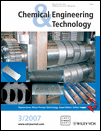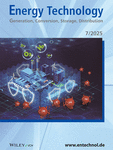Journal list menu
Export Citations
Download PDFs
Cover Picture
Overview
Contents
Editorial
Forum
Scientific Highlights
Scientific Highlights: Chem. Eng. Technol. 3/2007
- Pages: 293-294
- First Published: 28 February 2007
Research Articles
Micro Process Technology as a Means of Process Intensification
- Pages: 295-299
- First Published: 28 February 2007
Micro process technology provides the opportunity to realize chemical processes and plant designs faster and thus reduce investment and operating costs. One example given is the use of microstructured catalytic wall reactors as ‘boosters’ for conventional multitubular reactors.
Development of a Microreactor for Amino Acid Polymerization
- Pages: 300-304
- First Published: 28 February 2007
A microreaction system consisting of a micromixer and a capillary reaction component is developed for the continuous produc-tion of amino acid polymers. The resulting microreactor shows excellent controllability of the molecular weight distributions of amino acid polymers, homopolymers, and some copolymers.
Integration of a Microreactor in an Existing Production Plant
- Pages: 305-308
- First Published: 28 February 2007
Microstructured devices have increasingly been studied as tools for process intensification. This work describes the application of a microreactor integrated in an existing industrial plant with the aim of doubling the capacity of a two-step chemical process.
Porous Microfluidic Devices – Fabrication and Applications
- Pages: 309-315
- First Published: 28 February 2007
A fabrication method enabling the production of completely porous micro devices with user-defined channel networks is developed. In these devices, the channel walls act as membranes. The membrane characteristics can be tuned and may therefore be exploited for several applications.
Applicability of a Miniaturized Micro-Separator/Classifier to Oil-Water Separation
- Pages: 316-321
- First Published: 28 February 2007
A new micro-separator/classifier miniaturized compared to the original device was applied to oil-water separation. The miniaturization apparently resulted in the performance intensification. As a result, the smallest oil droplet size with 100 % efficiency became one tenth of the commonly suggested size for hydrocyclone.
A Microstructure Heat Exchanger for Quenching the Metabolism of Mammalian Cells
- Pages: 322-328
- First Published: 28 February 2007
Investigating the metabolome of a cell requires rapid quenching of the metabolism, quantitative extraction, and highly sensitive analysis of the metabolites. A metallic microstructured heat exchanger is introduced which allows fast cooling of mammalian cell suspensions without any detectable cell damage or cell disruption.
Synthesis of Analytically Pure Compounds in Flow Reactors
- Pages: 329-333
- First Published: 28 February 2007
Flow reactor tech-nology typically generates compounds in higher yield, purity and selectivity. Reaction conditions can be optimized rapidly enabling small quantities of analytically pure compounds to be prepared in minutes; alternatively, larger quantities of materials can be synthesized by simply operating numerous reactors in parallel.
High Rate Convergent Synthesis and Deposition of Polyamide Dendrimers using a Continuous-Flow Microreactor
- Pages: 334-340
- First Published: 28 February 2007
A convergent approach to the synthesis of polyamide dendrons and dendrimers, and the deposition G1 dendron on the aminosilanised glass surfaces were realized by using a con-tinuous-flow microreactor. Micro- reactors have proved to be an effective tool to synthesize the polyamide dendrons and dendrimers.
Formation of Polymer and Nanoparticle Doped Polymer Minirods by Use of the Microsegmented Flow Principle
- Pages: 341-346
- First Published: 28 February 2007
Swellable gel-like polymer rods were prepared in a microfluidic system by applying the segmented flow technique. The polymer rods were modified by introducing nanoparticles before polymerization and the synthesis of chromophoric groups after polymerization.
Formation of Au/Ag Nanoparticles in a Two Step Micro Flow-Through Process
- Pages: 347-354
- First Published: 28 February 2007
The formation of different Au/Ag nanoparticles and nanoparticle aggregates is studied in a two-step flow-through process using a glass/Si/glass static micromixer. The experiments show that the educt concentration ratios as well as the total flow rates effect the shape and composition of the nanoparticles.
Microreactor Processing for the Aqueous Kolbe-Schmitt Synthesis of Hydroquinone and Phloroglucinol
- Pages: 355-362
- First Published: 28 February 2007
Hydroquinone and phloroglucinol are used as substrates for aqueous Kolbe-Schmitt synthesis, using a novel processing methodology, termed high-p,T processing. By the high-p,T approach, the temperature limitations of classical batch synthesis can be overcome by simple technical expenditure, e.g., the use of a few microstructured components.
Controlled Hydrogen Oxidation in a Microstructured Mixer-Reactor Module
- Pages: 363-369
- First Published: 28 February 2007
A microstructured catalytic burner is designed which combines reaction, mixing, and heat transfer properties and allows a controlled, very fast, and highly exothermal reaction, such as the H2 oxidation relevant to various fields of application. The temperature peaks observed in previous experiments do no longer occur.
Inline Analysis in Microreaction Technology: A Suitable Tool for Process Screening and Optimization
- Pages: 370-378
- First Published: 28 February 2007
A procedure is de-scribed for successfully benchmarking different inline spectroscopic techniques (Raman, near infrared, and visible) in a microreaction plant. The experimental basis is the investigation of toluene nitration using two different nitrating agents. A calibration model is set up and validated within a defined parameter space.
Influence of Gravity on Two-Layer Laminar Flow in a Microchannel
- Pages: 379-382
- First Published: 28 February 2007
It is important to clarify the effect of gravity on laminar flow, since several microsystems require side-by-side laminar flow, which shows no interfacial tension. The influence of gravity on side-by-side laminar flow was quantitatively investigated using a computational fluid dynamics simulation.
Droplet Formation by the Collision of Two Aqueous Solutions in a Microchannel and Application to Particle Synthesis
- Pages: 383-388
- First Published: 28 February 2007
A new microreactor which is suitable for reaction crystallization without fouling is developed and applied to calcium carbonate precipitation and silver particle synthesis. The fluid dynamics in the microreactor are also investigated using a computational fluid dynamics simulation.
Flow Boiling of n-Hexane in Small Channels: Heat Transfer Measurements and Flow Pattern Observations
- Pages: 389-394
- First Published: 28 February 2007
Two different measurement methods are employed to study flow boiling heat transfer to n-hexane: infrared thermography for measuring the local heat transfer coefficients and a high speed camera for flow pattern observation. Both the experimental trends of the heat transfer coefficients and images of boiling regimes, are detailed.
Effect of Microchannel Plate Design on Fluid Flow Uniformity at Low Flow Rates
- Pages: 395-406
- First Published: 28 February 2007
From flow distribution in microstructured plates of varying geometries was concluded that at low flow rates channel/fin length, flow distribution chambers length, plate width, and shape of flow distribution chambers, and inlet/outlet location are the most important parameters that have to be considered in order to achieve uniform flow distribution.
Communication
The Impact of Microtechnologies on Chemical and Pharmaceutical Production Processes
- Pages: 407-409
- First Published: 28 February 2007
Microreaction Technology has been developed as a new chemical tool for process intensification. The technology is still at its early stage but has started to succeed its implementation in R&D labs of fine and specialty chemicals companies. The benefits of microreaction technology, both economically and technically, for research and production, are high-lighted.










